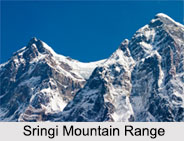 In Hindu mythology, Mount Sumeru also referred to as Meru, is known to be the heavenly abode of Lord Brahma. A river named Jambu flows past this region and the Sumeru Mountain is surrounded by many other mountain ranges. There are the Nilchala and Shveta mountain ranges in the north and south directions respectively while the Sringi Mountain lies beyond.
In Hindu mythology, Mount Sumeru also referred to as Meru, is known to be the heavenly abode of Lord Brahma. A river named Jambu flows past this region and the Sumeru Mountain is surrounded by many other mountain ranges. There are the Nilchala and Shveta mountain ranges in the north and south directions respectively while the Sringi Mountain lies beyond.
The Sringi Mountains are presently a part of the Nepalese Himalayan Mountain Range.
This article is a stub. You can enrich by adding more information to it. Send your Write Up to content@indianetzone.com















